I’m a sim racer with a passion for Motorsport, good racecraft and the tech side of sim racing. I made SIMRACINGCOCKPIT.GG as a place to share my experiences. I hold an International Class C race licence and write for sim racing store G-Performance and Motorsport resource Driver61.com
The Valve Index needs little introduction as Steam’s second-generation flagship VR headset. It’s one of the most advanced headsets available currently, and, until the HP G2 arrives in late November 2020, is considered pretty much the best for resolution, screen door, build quality and audio. (specs)
I’ve owned an Index since April 2020 and, while a little late to the game, I wasn’t disappointed. The total immersion in iRacing is frankly, game-changing. You’re surrounded by the sights and sounds of the simulation and after a few laps to orientate yourself (you can feel a little motion sick initially), you’re soon into faster lap times.
For me, it’s the way VR enables more natural use of vision on track. You’re looking into the corner on approach for the apex, and spotting the exit to get the best line through the corner. This of course is a pre-requisite to fast-track driving but I’ve found as a habit, it’s much easier to use this technique correctly in VR. I am faster with VR, and I find the good habits formed by having more realistic spatial awareness translate at the (real) racetrack too.
But what of the settings?
The first time you try VR you’ll probably be amazed, but depending on your setup you can become quickly disappointed. Mostly because what looks good on the monitor really doesn’t translate well when the image is being mainlined straight into your eyeballs. So after the first few laps you’ll notice issues. In particular, the shadow effects in the cockpit make the dashboard flicker and wriggle so much you think you’re having a migraine.
Regardless of whether you own an Index, an Oculus Quest, or a HTC Vive, this approach to your settings should enable improved gameplay. Note this article does not cover Windows VR settings. Sorry!
Don’t let this put you off though. Like all things sim, it must be tuned. After many hundreds of hours spent in VR I’m sharing my settings here. Remember there is always variance in settings from PC to PC. It’s also subjective! So, play around and don’t be scared of breaking things because you can’t.
NVIDIA control panel
Very few changes are required in the Nvidia Control panel (in my humble opinion). Open the control panel and select “Manage 3d settings”.
Sometimes, it doesn’t appear in the desktop menu options. When that happens, it’s best just to remove the driver and start again with the standard driver, as per these helpful comments.
As usual, these settings are somewhat subjective in that they work on my setup nicely. Don’t be afraid to play with the settings; if you go wrong you can always reset to default and start again.
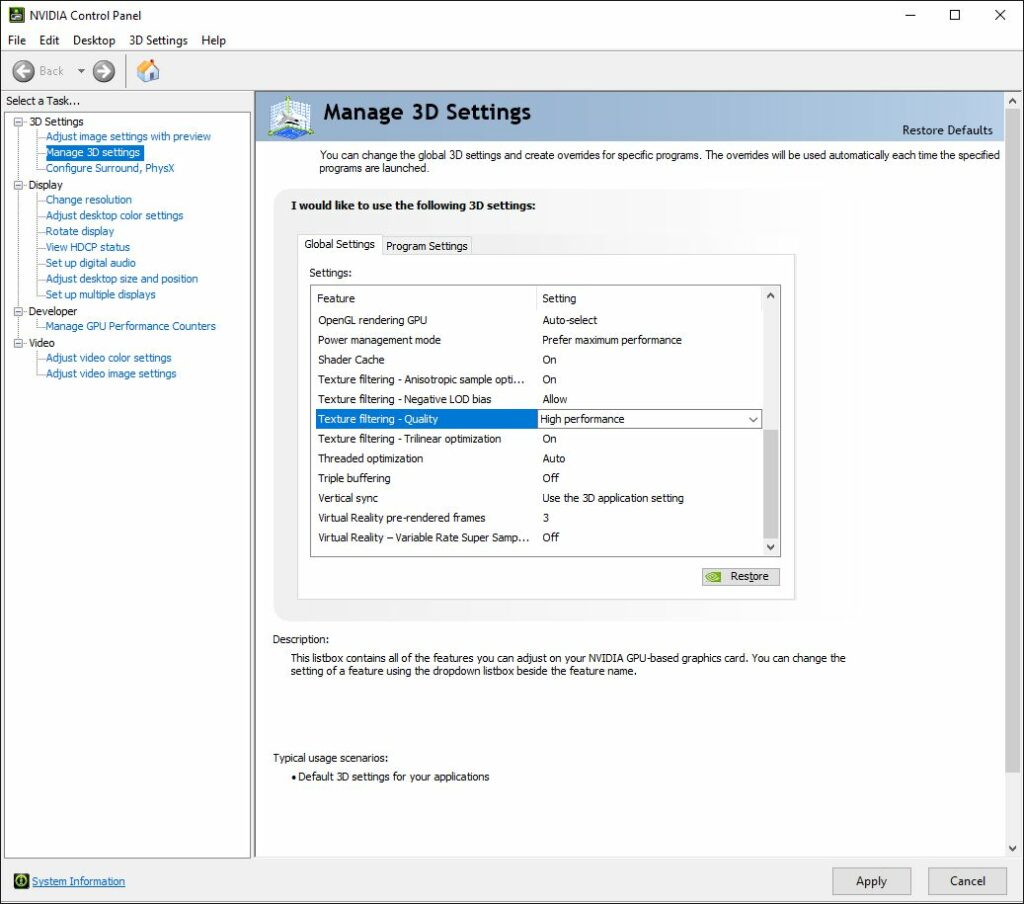
Scrolling from top to bottom, here are the best VR settings that work well with my NVIDIA RTX 2080 ti:
- Anti-aliasing – Transparency to 2x (supersample)
- Power management to “Prefer maximum performance”
- Texture filtering to “High performance”
- VR Prerendered frames = 3 (helps to eliminate any potential for stuttering)
Steam VR
Steam’s VR engine is the software controller for the Valve Index, using OpenVR’s engine it provides all of the spatial detection APIs and Graphics endpoints for the headset to function. Steam VR also works with the Oculus Rift, Oculus Rift S, HTC Vive, HTC Vive Pro, HTC Vive Cosmos and Pimax 4K, 5K, 5K Plus, 8K, and 8K Plus headsets.
The Valve Index does still have some annoying tracking loss-related problems which some of these settings go a long way to resolving. The grey screen issue is by far the most irritating – you put the headset down to go to the loo (usually just before the race) to find that the headset can’t lock into tracking again and therefore won’t render an image – the amount of iRating I’ve lost for not turning up to a race to try to solve this problem! Read on for the solution.
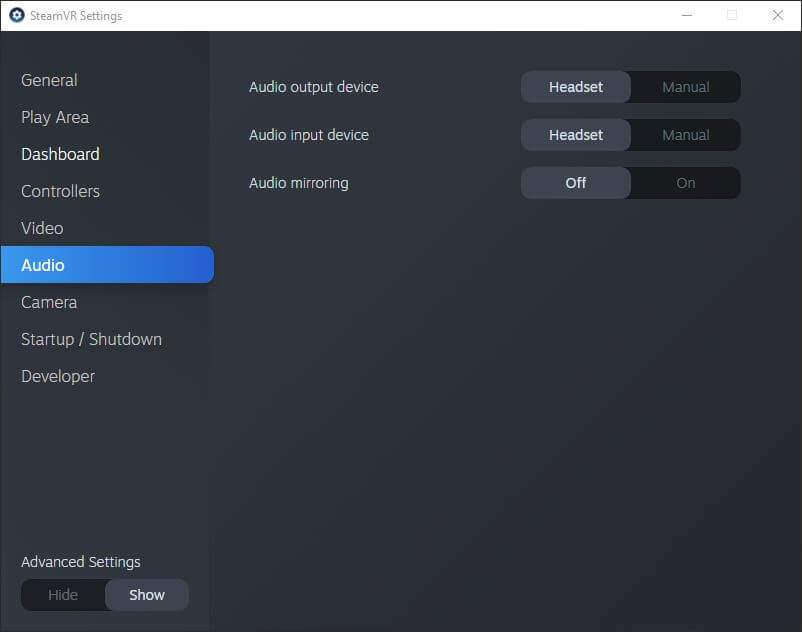
Pretty much all of this is the default except where I’ve mentioned a different setting. Firstly, head to General settings:
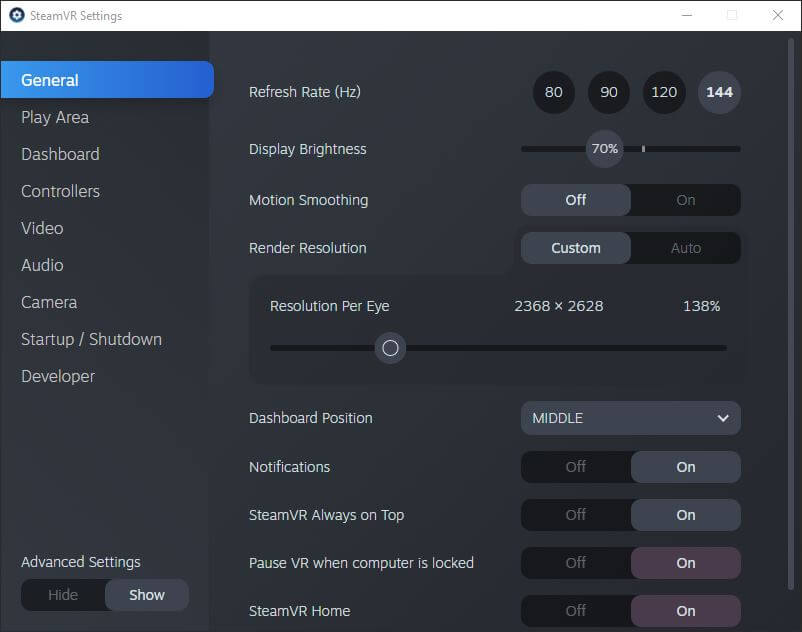
I set the refresh at 144hz (this is *the* Valve Index feature, might as well use it!). 120hz is also absolutely fine if 144 is too high. I’d advise you just try these settings and see how you get on though.
Display brightness I set at 70%. 100% is too bright! This has no bearing on performance, other than my own.
Don’t use motion smoothing, unless you want to feel unwell after 10 minutes.
Set render resolution to “custom”. I run a high render resolution at 138%. If your card can do it, go for it. Otherwise drop this a little to tune, or drop refresh to 120 to accommodate.
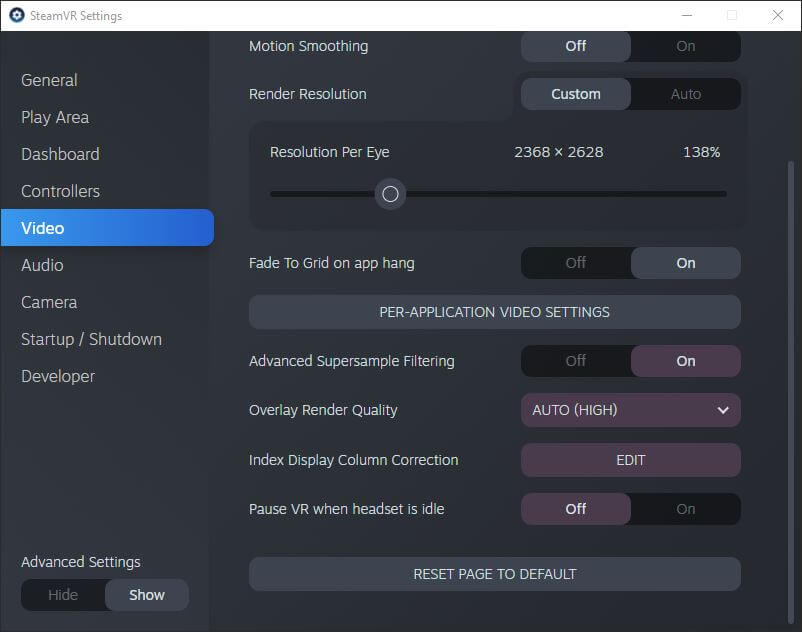
Set advanced supersample filtering to on.
Just a quick note on the startup / shutdown settings – set a reasonably higher value than default for “turn off displays after” – mine was set to 30 seconds! When you take the device off, it shuts down very quickly. This shut down is sometimes unrecoverable as tracking won’t re-initiate and all you get is a grey screen.
Next, we’ll look at the Steam VR graphics options.
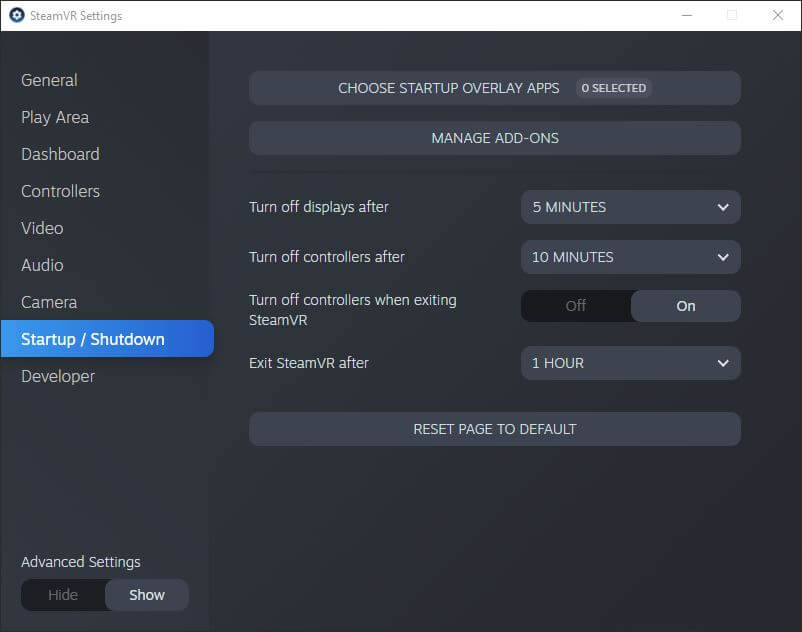
iRacing graphics Settings for VR
Finally, time to tweak your iRacing graphics settings. Here’s mine:
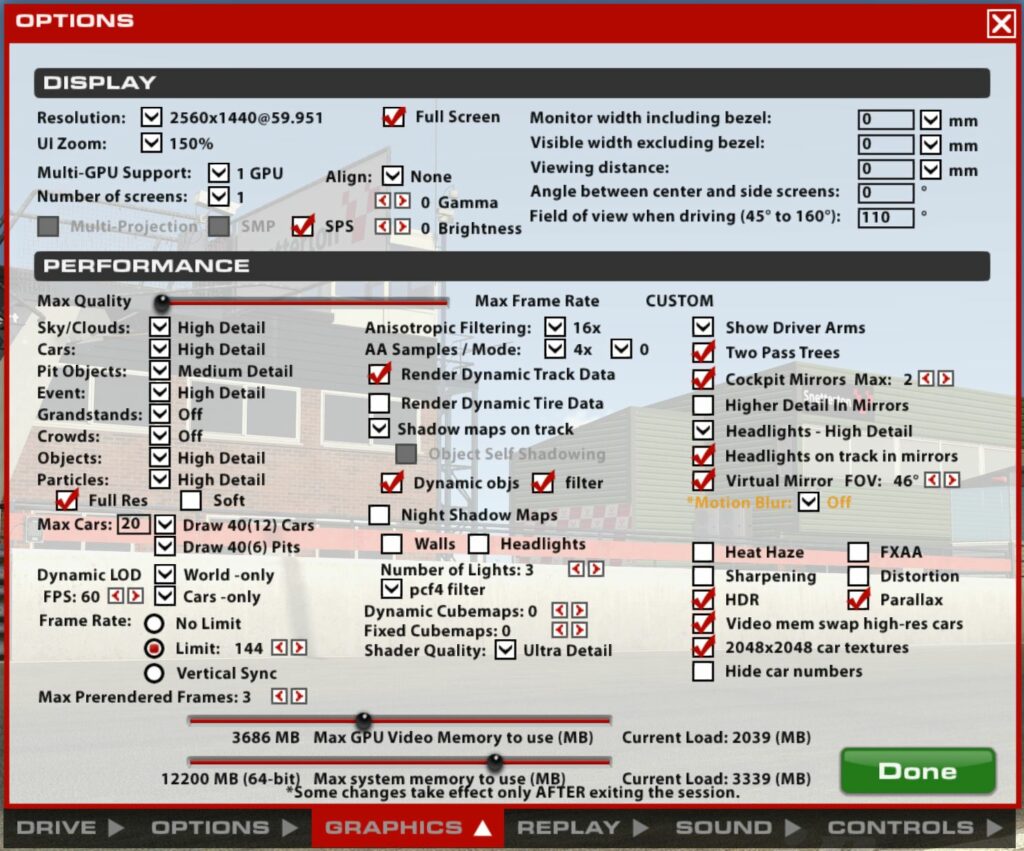
For the most part, a lot of these settings are default. Under “display” I have SPS turned on (GeForce GTX 1060 and higher; as far as I understand it’ll work with most later AMD graphics via OpenGL support. SPS either works or it doesn’t. Give it a try.
Under “performance”, there’s quite a lot of difference to be made. I go for maximum performance using customisations.
Sky/Clouds and Cars: use High Detail.
Pit objects: Medium detail
Event: High detail
Grandstands and Crowds: Off
Objects: High detail
Particles: High detail at Full resolution
Dynamic LOD: World -Only
Frame rate: 144
Max pre-rendered frames: 3 matching the NVIDIA settings
Anisotropic filtering: 16x
AA samples: 4x (to smooth out the jagged edges)
Render dynamic track data: on
Render dynamic tyre data: off
Shadow maps: on track leaves shadows on the circuit but removes the weird flickering from the dash and inside the car
Dynamic cube maps: off – light reflections on surfaces can be weird and annoying
I think the rest of it is more or less default but check your settings thoroughly against mine!
One final note, I run iRacing with a 130° field of view. As I understand it this is the production specification of the headset itself, so it makes sense to me to configure FOV in Racing the same:
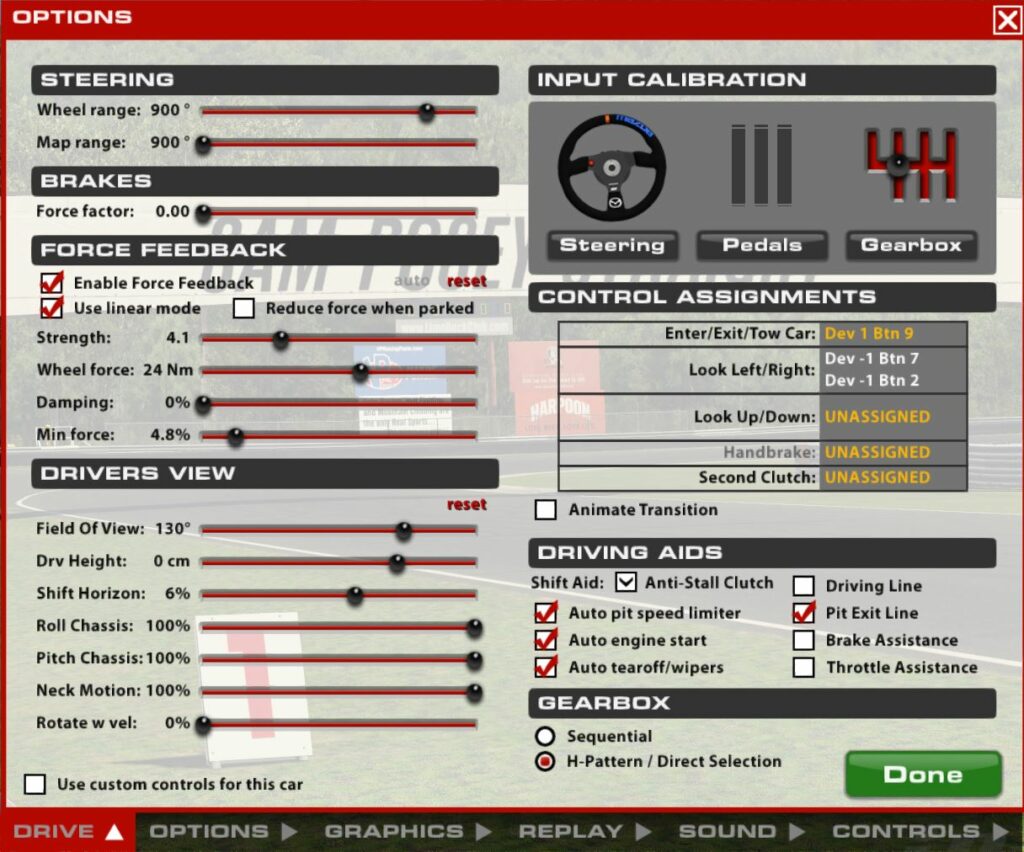
Related posts:
Topic: iRacing


